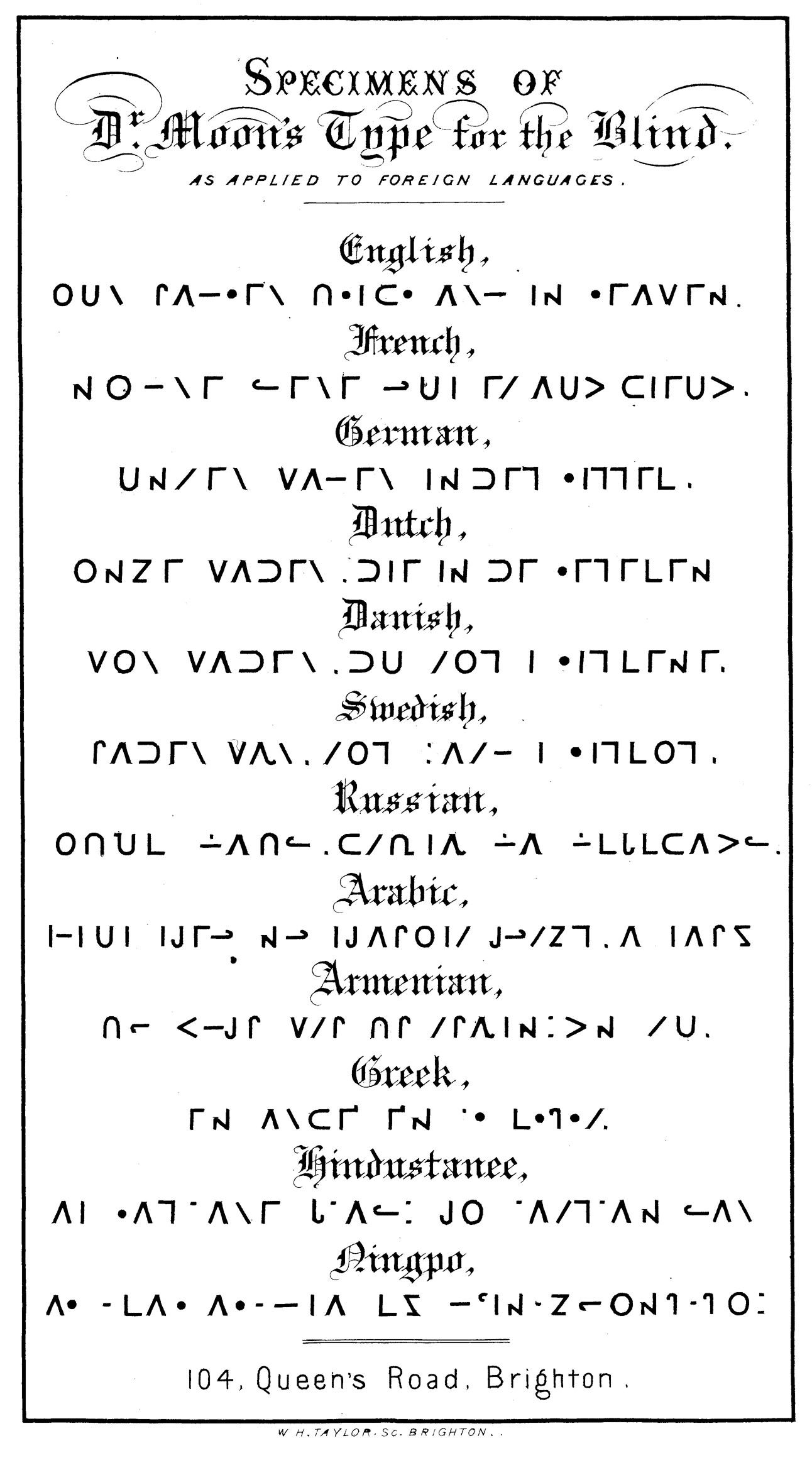How a Blind Doctor’s ‘Moon Code’ Helped Thousands Read Again
In the 1840s, Dr. William Moon remade the Roman alphabet to help his students.

At first glance, the unfamiliar alphabet above, pressed into the page beneath our own, seems a bit opaque. With its streamlined swoops, angles and dashes, it appears to belong elsewhere—like writing from the past, or the future, or a different planet.
Put it a little time, though, and you’ll find it’s not so hard to figure out what’s going on. This isn’t a cipher, meant to leave people out—it’s a system, invented to let people in. This is Moon Code, a reading language for the blind which, although overshadowed by Braille, has given a specific population the chance to read again for hundreds of years.
Moon Code was invented by Dr. William Moon, a bookish lawyer and teacher from a village in Kent, England. As a young man, Moon had wanted to be a priest. But an early bout of scarlet fever left him blind in one eye, and, as the years went on, his remaining sight slowly eroded. By the time he was 22, he couldn’t see at all.
Moon had already learned several of the existing reading systems for blind people. At the time, there were various species of “embossed letters,” which were ordinary Roman letters that stuck out of the page, sometimes printed in italics or uppercase for increased ease of touch. There was James Hatley Frere’s “Frere system,” a phonetic alphabet made up of various shapes and symbols, with each based on a particular sound. And there was the still-familiar Braille, which had been introduced a few years earlier.
Although Moon continued his studies after going blind, he found his immediate priorities were changing. He began sharing his knowledge, opening a school in his home to teach other vision-impaired people how to use these existing systems.

But in the classroom, he found problems with each of them—especially when he tried teaching them to adults. Embossed Roman letters were too confusing, due to their “numerous lines and intricate forms,” he wrote later, in The Consequences & Ameliorations of Blindness. The Frere system, while simpler, was “burdened with numerous contractions,” and encouraged incorrect pronunciation. Braille, “although useful to children, is also found unsuitable for the adult,” especially “if he be accustomed to rough manual labor”—calloused fingers found it hard to distinguish the dots.
In 1845, in response to these frustrations, Moon took matters into his own hands. He invented a new method, which he called “Moon’s System of Embossed Reading,” but which soon became known as “Moon Type,” or “Moon Code.” The Moon System is also based on Roman type, but each letter is simplified into a basic set of lines or curves: “A” is an inverted V, “B” is a simple fishhook, and “S” is a forward slash. By removing excess strokes, the shapes are left, in Moon’s words, “open and clear to the touch.”
In a strategy borrowed from Frere, pages of text were arranged in “ox-ploughing succession”—the first line is printed left-to-right, the next right-to-left, and so on. Instead of returning to the beginning of the page each time, and potentially losing her place, the reader can move her hand continuously, like an oxen marching up and down rows.

Early experiments were promising. “Many who for years had made futile attempts to learn by other systems, have easily accomplished this,” he wrote. “Many of those who could read before losing their sight, have learnt it in one lesson.” The rugmakers and basket-weavers, whose calloused fingers he originally had in mind, could manage it easily. Even better, both blind and sighted people could pick it up extremely quickly, and teach others in turn.
With the help of some friends, Moon had Moon Code printing plates made up, and began publishing a monthly magazine from his house. He soon moved on to the Bible, which he printed in chunks. He kept up his teaching, which gave him more and more ideas—after meeting a blind girl who thought that horses walked upright on two legs, he started embossing illustrations, and he also issued music, maps, and geometry lessons.
By 1875, Moon had printed, in his own words, “37 volumes of Religious Works, 53 Biographies, 49 volumes of Tales and Anecdotes, 27 of Poetry, [and] an Atlas of the Stars.” He spent the rest of his life traveling the world, teaching his system at various schools and societies. By his death in 1894, groups everywhere from England to Norway to Syria taught Moon Code, and circulated books.
Although Moon Code was, at one time, one of the world’s more popular reading systems, it was quickly surpassed by Braille, which, with its all-dot format, is much easier to print and produce. Moon Code “is almost never offered as an alternative format for items such as household bills, bank statements, and restaurant menus,” writes the Royal National Institute of Blind People. But the group still encourages its use, especially among the audience Moon originally envisioned: people whose lives have left them with less sensitive eyes and fingers, who still want to make their way across the page.

















Follow us on Twitter to get the latest on the world's hidden wonders.
Like us on Facebook to get the latest on the world's hidden wonders.
Follow us on Twitter Like us on Facebook